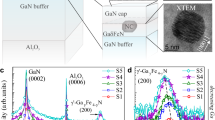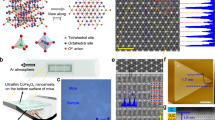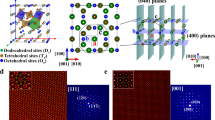Abstract
THE discovery of spin-dependent electronic phenomena in magnetic multilayers1 and granular solids2,3 has provided valuable insights into the nature of spin interactions in low-dimensional magnetic systems, and has opened the way to new technologies based on these phenomena. In the case of semiconductors, the incorporation of microscopic magnets would allow the electronic flexibility of semiconductor-based quantum structures to be combined with local magnetism4, potentially enabling the development of new tunable spin-dependent magneto-electronic and magneto-optical devices. Recent attempts to introduce ferromagnetism into III–V compound semiconductors have involved epitaxial growth of atomically thin layers, yielding two-dimensional magnetic films5 rather than localized magnetic structures. Here we describe a simple approach for fabricating discrete microscopic ferromagnets in the III–V semiconductor gallium arsenide. The semiconductor is first uniformly implanted with manganese ions. Subsequent heat treatment leads to a striking phase separation, whereby submicrometre crystals of GaMn nucleate and grow from the implanted layer. The resulting particles are ferromagnetic, with Curie temperatures exceeding room temperature.
This is a preview of subscription content, access via your institution
Access options
Subscribe to this journal
Receive 51 print issues and online access
$199.00 per year
only $3.90 per issue
Buy this article
- Purchase on Springer Link
- Instant access to full article PDF
Prices may be subject to local taxes which are calculated during checkout
Similar content being viewed by others
References
Parkin, S. S. P., Bhadra, R. & Roche, K. P. Phys. Rev. Lett. 66, 2152–2155 (1991).
Berkowitz, A. E., Mitchell, J. R., Carey, M. J. & Young, A. P. Phys. Rev. Lett. 68, 3745–3748 (1992).
Xiao, J. Q., Jiang, J. S. & Chien, C. L. Phys. Rev. Lett. 68, 3749–3752 (1992).
Prinz, G. Science 250, 1092–1097 (1990).
Tanaka, M. et al. Appl. Phys. Lett. 63, 696–698 (1993).
Shechtman, D., Blech, I., Gratias, D. & Cahn, J. W. Phys. Rev. Lett. 53, 1951–1953 (1984).
Tsuboya, I. & Sugihara, M. J. phys. Soc. Japan 18, 1096 (1963).
Wachtel, E. & Neirl, K. J. Z. Metallkd. 56, 779–789 (1965).
Massalski, T. B., Okamoto, H., Subramanian, P. R. & Kacprzak, L. (eds) Binary Alloy Phase Diagram 2nd edn Vol. l 295 (Am. Soc. Metals, Metals Park, OH, 1990).
Kikkawa, J. M., Baumberg, J. J., Awschalom, D. D., Leonard, D. & Petroff, P. M. Phys. Rev. Rapid Commun. B50, 2003–2006 (1994).
Pekarek, T. M. et al. Appl. Phys. Lett. (submitted).
J. Shi et al. J. appl. Phys. (submitted).
Author information
Authors and Affiliations
Rights and permissions
About this article
Cite this article
Shi, J., Kikkawa, J., Proksch, R. et al. Assembly of submicrometre ferromagnets in gallium arsenide semiconductors. Nature 377, 707–710 (1995). https://doi.org/10.1038/377707a0
Issue Date:
DOI: https://doi.org/10.1038/377707a0
This article is cited by
-
Effect of thermal annealing of high temperature growth [(GaAs) m (Fe) n ] p composite films on GaAs(001) by molecular beam epitaxy
Indian Journal of Physics (2011)
-
Fe–Ga–As precipitates and their magnetic domain structures in high-dose iron implanted GaAs
Journal of Materials Science (2011)
-
No Intrinsic Ferromagnetism in Transition-Metal-Doped ZnO: an Electron Paramagnetic Resonance Analysis
Applied Magnetic Resonance (2010)
-
Study of high energy Mn+1 ion implantation in GaAs
Applied Physics A (2009)
-
Decagonal quasicrystal and related crystalline phases in Mn-Ga alloys with 52 to 63 a/o Ga
Metallurgical and Materials Transactions A (1997)
Comments
By submitting a comment you agree to abide by our Terms and Community Guidelines. If you find something abusive or that does not comply with our terms or guidelines please flag it as inappropriate.



